The Philippines is a key player in the South China Sea dispute, primarily due to China’s expansive Nine-Dash Line claims.
Historically, the Philippines has asserted sovereignty over the Spratly Islands since the 1950s.
In 2016, an arbitration ruling under the United Nations Convention on the Law of the Sea (UNCLOS) favored the Philippines, declaring China’s Nine-Dash Line and land reclamation activities unlawful.
Currently, tensions involve Chinese interference with Philippine resupply missions and the use of “gray zone” tactics.
This dispute highlights China’s conflict with international law, particularly concerning freedom of navigation and maritime boundaries.
Historical Context of the Dispute
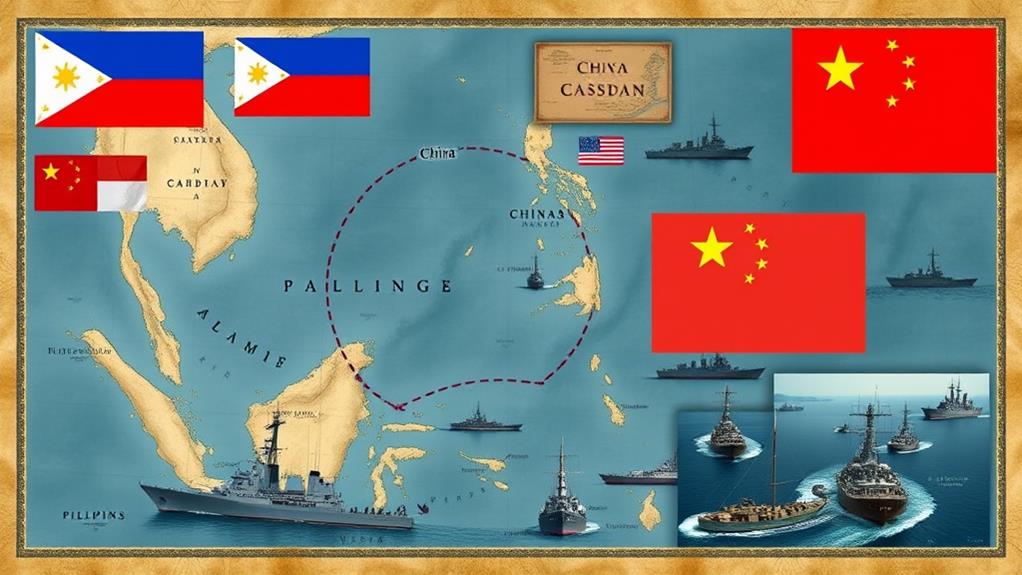
The South China Sea dispute has a complex and tumultuous history, with roots tracing back to the early 20th century.
In 1950, Philippines President Elpido Quirino asserted his nation’s sovereignty over the Spratly Islands, citing their importance for the Philippines’ security, given their use by Imperial Japan during World War II. This claim was met with strong opposition from the People’s Republic of China (PRC), which denounced Quirino’s statements and reiterated China’s claim over the Spratly Islands.
The dispute intensified in 1951, when Zhou Enlai, the PRC’s Foreign Minister, criticized the draft Treaty of Peace with Japan for not restoring sovereignty over the Spratly and Paracel Islands to China. This marked a significant escalation, as both China and Vietnam began to assert their claims over these islands.
In the subsequent decades, the dispute continued to simmer, with periods of relative calm punctuated by outbreaks of violence. For instance, the early 1970s saw a scramble for islands due to the discovery of potential oil reserves, followed by China’s invasion of several islands in the South China Sea in 1974, leading to further tensions.
These historical events laid the groundwork for the ongoing territorial disputes in the South China Sea.
Key Claimant Countries Involved
The South China Sea dispute involves multiple countries, each with their own historical and geographical claims.
Key Claimant Countries
The South China Sea dispute is complex, with several nations asserting territorial rights.
China claims the Nine-Dash Line, Paracel and Spratly Islands, citing historical maps and sovereignty since 1947.
The Philippines claims Scarborough Shoal and Spratly Islands, based on geographical proximity and historical fishing grounds.
Vietnam asserts claims over Paracel and Spratly Islands, citing historical sovereignty since the 17th century.
Malaysia and Brunei claim southern parts of Spratly Islands, citing economic exclusion zones and the United Nations Convention on the Law of the Sea (UNCLOS).
These countries’ overlapping claims are fueled by the strategic and economic importance of the South China Sea.
China’s Nine-Dash Line claim is particularly contentious, as it overlaps with the claims of other countries and has been rejected by international arbitration in favor of the Philippines.
The dispute remains unresolved, with tensions escalating due to increased military presence and resource exploitation activities.
China’s Land Reclamation Efforts
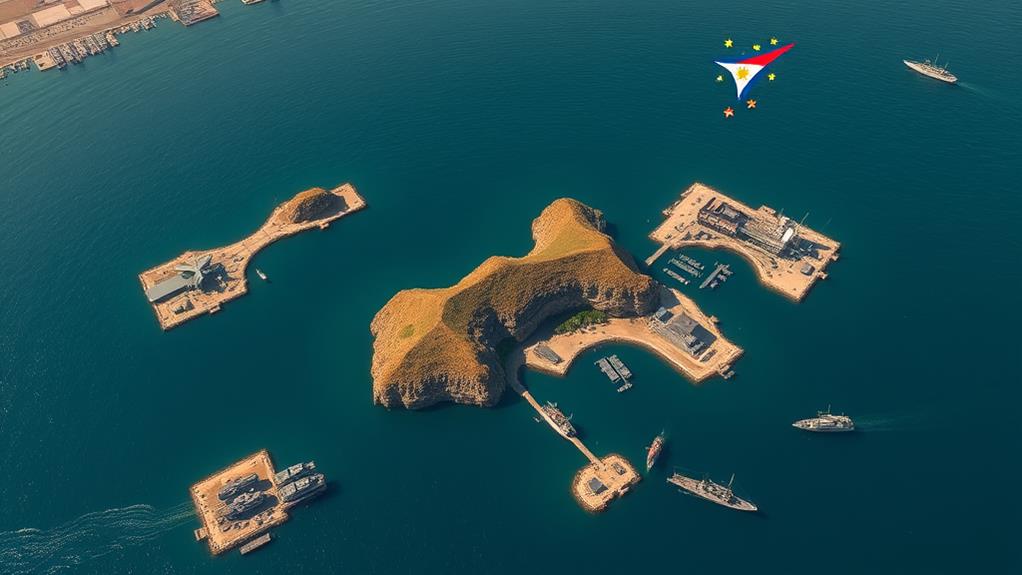
China’s land reclamation efforts in the South China Sea have significantly altered the geographical landscape, escalating tensions among claimant nations. Since 2013, China has created about 3,200 acres of new land by undertaking extensive reclamation and construction on several reefs in the Spratly Island chain.
Seven features in the Spratlys have been primarily focused on, including Fiery Cross Reef, Subi Reef, and Mischief Reef, with the majority of reclamation completed by late 2015. These new land features have been militarized with the development of various infrastructure, such as 10,000ft runways, large ports, and deep channels.
The construction of communications, logistics, and intelligence gathering facilities has bolstered China’s long-term control over the maritime area.
Despite assertions that the reclamation is for public service and to support fishermen, the militarization of these islands has raised concerns about China’s intentions and has heightened regional tensions.
China’s strategic calculus aims to assert its sovereignty claims without provoking open conflict with the United States or other regional actors.
2016 Arbitration Ruling and Aftermath
In 2013, the Philippines initiated arbitral proceedings against China under the United Nations Convention on the Law of the Sea (UNCLOS), challenging China’s extensive claims in the South China Sea. This move sought to clarify the legal status of China’s actions within the context of international legal frameworks.
The tribunal ruled overwhelmingly in favor of the Philippines, concluding on July 12, 2016. The ruling emphasized the importance of addressing territorial integrity.
Key points from the ruling and its aftermath:
China’s nine-dash line has no basis under international law. The tribunal declared that China’s claimed historic rights within the nine-dash line were invalid.
China violated the Philippines’ sovereign rights. The tribunal found that China had violated the Philippines’ sovereign rights in its exclusive economic zone (EEZ).
China’s land reclamation activities were unlawful. The tribunal determined that China’s land reclamation activities in the South China Sea were illegal.
China refused to participate in the arbitration and rejected the ruling. China didn’t participate in the arbitration and refused to accept the ruling, calling it “null and void”.
Enforcing the ruling remains a challenge. The ruling’s enforcement and acceptance remain a challenge, as China continues to assert its claims, and the international community grapples with the implications for maritime law and regional stability.
Despite the ruling, tensions in the South China Sea have persisted, highlighting the complexities and challenges of resolving such disputes through international arbitration.
Strategic Importance of the Region
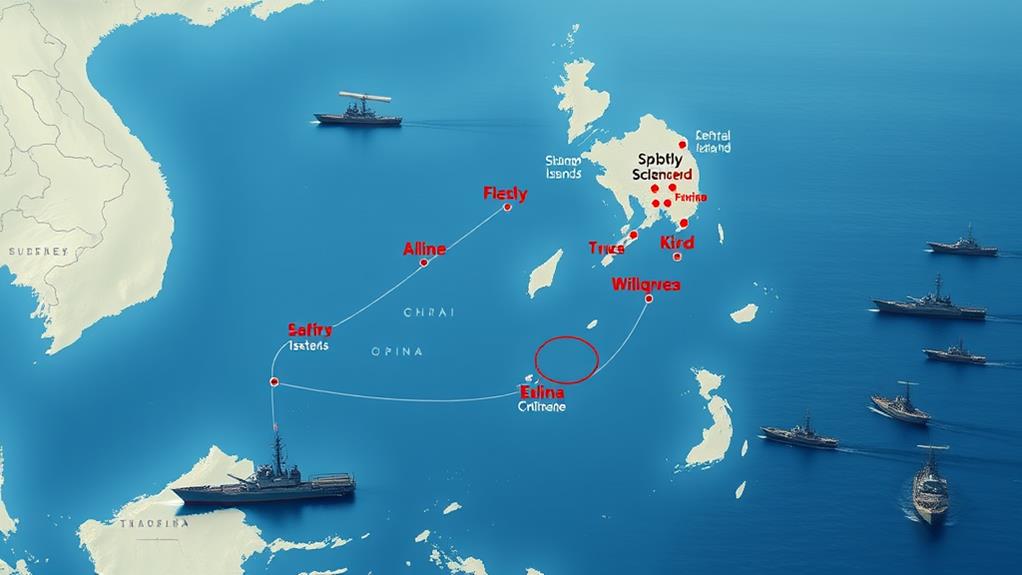
Strategic Importance of the South China Sea
The South China Sea is a region of paramount strategic importance, frequently at the center of geopolitical tensions. As a vital crossroads of global trade, it hosts some of the busiest shipping lanes in the world, with over $5 trillion in annual trade passing through its waters. The region is estimated to contain significant reserves of crude oil and natural gas, making it a crucial area for energy security.
Historical Significance and Economic Importance
The rich historical trade routes in the South China Sea, similar to the significance of the Pasig River, emphasize how vital waterways can shape economies and cultures.
For example, the sea’s strategic location has enabled the growth of major economies such as China, Japan, and South Korea.
Military Perspective and Power Projection
From a military perspective, the South China Sea’s strategic location allows control over key maritime routes, enhancing the power projection capabilities of any nation dominating the area.
China’s aggressive behavior, including land reclamation and militarization of islands, underscores its aim to achieve regional hegemony. For instance, China has constructed ports, military installations, and airstrips in the Paracel and Spratly Islands.
Global Maritime Stability and Freedom of Navigation
The U.S. recognizes the region’s importance in ensuring freedom of navigation and access to vital sea lines of communication (SLOCs).
The U.S. has conducted freedom of navigation operations to challenge China’s claims, highlighting the region’s significance in maintaining global maritime stability.
Regional Significance for the Philippines
For the Philippines, defending its presence in the South China Sea is crucial, as it involves protecting its exclusive economic zone (EEZ) and ensuring the safety of its soldiers stationed in contested areas.
Natural Resources and Economic Interests
The intense competition in the South China Sea is driven by the region’s rich natural resources and critical economic interests.
The South China Sea is estimated to contain significant reserves of oil and natural gas, making it a prized area for energy-hungry nations.
Oil Reserves: The region is estimated to hold 11 billion barrels of oil, comparable to major oil-producing countries like Kuwait.
Natural Gas: The South China Sea has potential reserves of 190 trillion cubic feet, a substantial find in the global energy landscape.
Fisheries: The region accounts for 10% of the world’s fishery resources, crucial for the food security of many nations.
Strategic Trade Routes: Approximately 30% of global maritime trade passes through the South China Sea, making it a critical passage for international commerce.
Economic Development: The seabed and subsoil resources extend far beyond oil and gas, with significant potential for benefiting the economies of claimant countries.
These resources have fueled territorial claims and heightened tensions among China, the Philippines, Vietnam, Malaysia, Brunei, Taiwan, and Indonesia.
The dispute is further complicated by overlapping territorial claims and the lack of a mutually accepted resolution framework under international law.
Current Tensions and Clashes
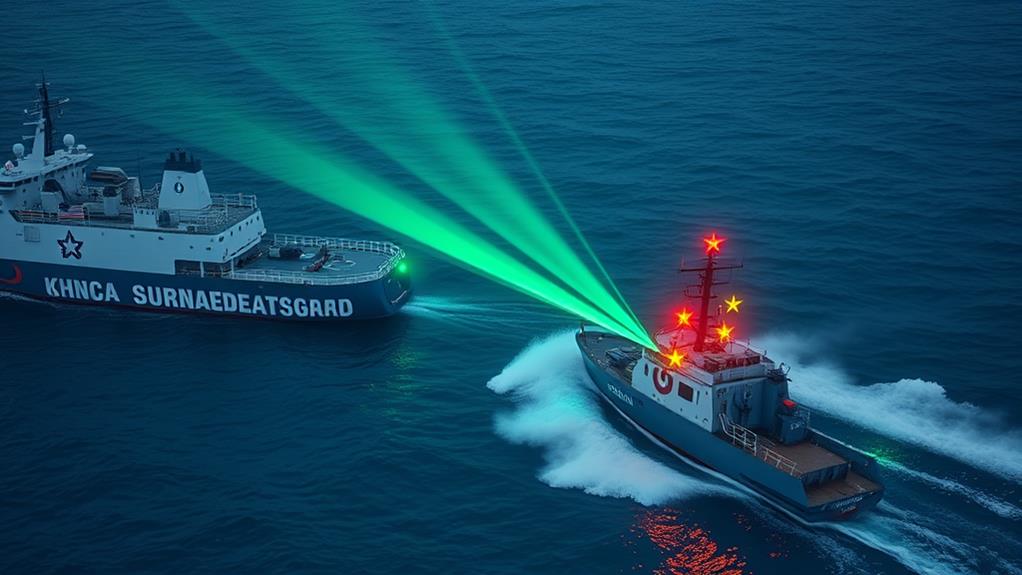
Tensions in the South China Sea are escalating due to China’s increasing assertiveness and rejection of international arbitration rulings.
China is putting pressure on the Philippines, particularly around Second Thomas Shoal, where a Philippine garrison is stationed on a grounded World War II-era ship. This location is strategically important, similar to Corregidor, a historical fortress.
Chinese Coast Guard vessels and fishing boats, likely part of China’s maritime militia, have interfered with Philippine resupply efforts. They’ve used “gray zone” and “hybrid warfare” tactics, such as using water cannons, ramming Philippine vessels, and deploying military-grade lasers, to avoid direct confrontation.
These actions have resulted in damages and injuries to Philippine personnel.
China’s strategy is to blur the lines between military and civilian actions, avoiding escalation and potential U.S. intervention.
Despite bilateral agreements aimed at de-escalation, underlying disputes remain unresolved. China refuses to accept the 2016 Hague tribunal ruling and continues to claim territories based on the nine-dash line, making a lasting resolution challenging.
How Does the Archipelagic Doctrine Impact the Philippines’ Territorial Claims in the South China Sea Dispute?
The Archipelagic Doctrine significantly bolsters the Philippines’ territorial claims in the South China Sea dispute by legally defining its archipelagic baselines. This doctrine plays a crucial role in the Philippine maritime territory protection, ensuring that the country’s sovereignty and rights are upheld in these contentious waters.
International Law and Maritime Boundaries
International Law and Maritime Boundaries
China’s claims in the South China Sea have been consistently at odds with international law, particularly the United Nations Convention on the Law of the Sea (UNCLOS).
The 2016 Ruling Against China: The arbitral tribunal ruled overwhelmingly in favor of the Philippines, declaring that China’s nine-dash line and recent land reclamation activities were unlawful. This ruling is significant because it clarifies the rights of nations in the South China Sea, much like the strategic importance of Corregidor Island during World War II.
China’s Non-Acceptance: China maintained that the ruling was “null and void” and refused to participate in or accept the arbitration proceedings, which undermines the authority of international law.
Exclusive Economic Zones (EEZs): The tribunal clarified that China’s claims over large swaths of the South China Sea, including areas within the EEZs of other nations, weren’t valid under UNCLOS. This means that other nations have the right to explore and exploit resources within their EEZs without Chinese interference.
Freedom of Navigation: The ruling also emphasized the right of freedom of navigation, which is crucial for international maritime trade and security. This ensures that ships can pass through the South China Sea without restrictions, promoting global trade and commerce.
The International Community’s Role: The long-term implications of this ruling depend on the extent to which the international community supports and enforces it, ensuring that maritime boundaries are respected according to international law. This means that other nations must work together to uphold the principles of UNCLOS and protect the rights of nations in the South China Sea.
These points highlight the complex interplay between China’s territorial claims and the principles of international maritime law.
Strengthening Alliances for Security
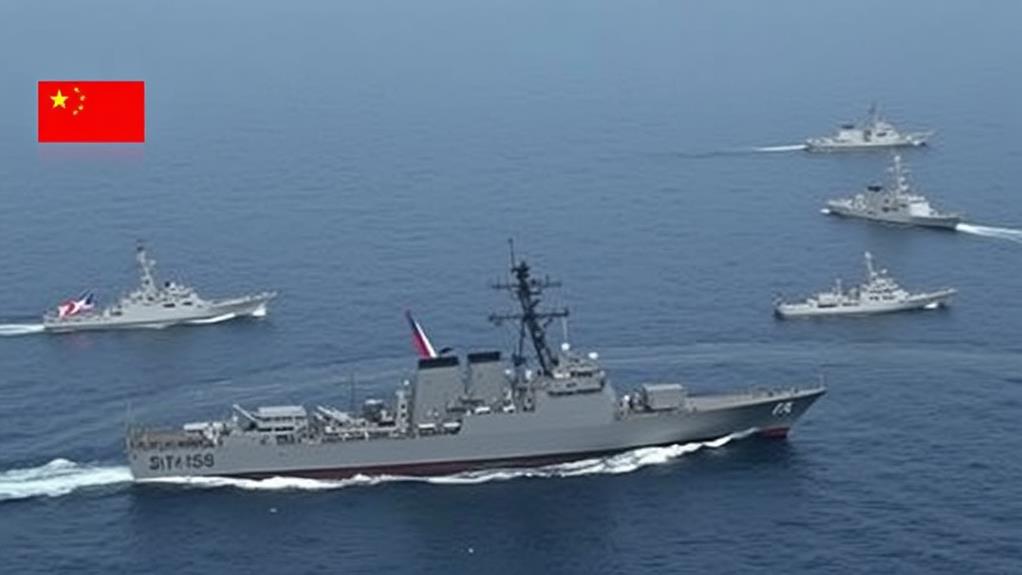
Strengthening Security Alliances
As tensions in the South China Sea escalate, the Philippines is bolstering its security alliances to counter China’s assertive territorial claims. The country has strengthened its partnerships with the United States and Japan to enhance its maritime security capacity. This cooperation is crucial in maintaining regional stability and safeguarding sovereignty.
Historical Context
The Philippines has faced challenges in maintaining territorial integrity, much like the strategic defenses that Corregidor Island represented during past conflicts. This underscores the importance of military preparedness in safeguarding sovereignty. For instance, Philippine President Ferdinand Marcos Jr. has signed deals with the U.S. to increase base access, joint exercise training, and weapons transfers.
U.S. Commitment
The U.S. has reaffirmed its commitment to the Mutual Defense Treaty with the Philippines, which extends to both countries’ armed forces, public vessels, and aircraft in the South China Sea. This commitment is vital in deterring Chinese aggression and ensuring the freedom of navigation in the South China Sea, which is crucial for global trade and security.
Japan’s Support
Japan has supported the Philippines by selling military ships and equipment, further solidifying the country’s defense capabilities. These alliances are pivotal in deterring Chinese aggression and ensuring the freedom of navigation in the South China Sea.
Philippine Aims
Questions and Answers
How Does the US Support the Philippines in the South China Sea Disputes?
The US provides multifaceted support to the Philippines in the South China Sea disputes.
The US reinforces its Mutual Defense Treaty (MDT) with the Philippines, extending protection to its armed forces and public vessels in the disputed waters. This treaty serves as a deterrent to potential aggressors, ensuring the security of the Philippines in the face of territorial disputes.
The US also conducts freedom of navigation operations to challenge China’s claims in the South China Sea. These operations involve the US Navy sailing its warships and aircraft near artificial islands built by China, asserting the right to freedom of navigation in international waters.
In addition, the US provides military assistance, such as selling equipment to enhance the Philippines’ maritime security capabilities. This aid enables the Philippines to strengthen its military presence in the disputed waters, bolstering its ability to defend its territorial claims.
Furthermore, the US offers diplomatic support, including monitoring the situation through “visuals” to help de-escalate tensions. This support involves the US providing intelligence and surveillance data to the Philippines, enabling it to better respond to potential threats in the region.
What Role Does Japan Play in the South China Sea Disputes?
Japan’s Role in South China Sea Disputes
Japan isn’t a direct participant in South China Sea disputes, but it has significant strategic and economic interests in the region.
Its energy imports and trade rely heavily on the free and open seas. Japan is concerned about China’s growing assertiveness and militarization in the area.
It advocates for upholding international law to ensure the peaceful resolution of disputes. To achieve this, Japan cooperates with ASEAN and the U.S. to maintain stability in the region.
How Do Environmental Concerns Impact the South China Sea Disputes?
Environmental concerns intensify tensions in the South China Sea disputes.
The destructive impact of human activities in the South China Sea is evident. China’s dredging activities have devastated coral reefs, which are essential for marine biodiversity. For instance, the construction of artificial islands has led to the destruction of over 120 square kilometers of coral reefs.
Overfishing and pollution have also severely degraded the environment, affecting fisheries and the ecosystem as a whole.
These actions violate international law, particularly the United Nations Convention on the Law of the Sea (UNCLOS).
Cooperative environmental management and science-based solutions are necessary to mitigate the damage. This can be achieved through joint efforts to monitor and manage the region’s ecosystem, as well as the adoption of sustainable fishing practices.
What Are the Implications of China’s Refusal to Accept the 2016 Arbitration Ruling?
China’s refusal to accept the 2016 arbitration ruling has significant implications.
It deepens regional tensions because China continues to assert its claims despite the tribunal’s findings that such actions are unlawful. This stance undermines international legal authority and may lead to escalating conflicts.
Diplomatic progress is complicated as other states view China’s actions as a challenge to the rule of law and regional stability.
For instance, neighboring countries may feel threatened by China’s non-compliance, leading to increased tensions in the region.
How Do Local Fishermen Cope With the Disputes in the South China Sea?
When coping with disputes in the South China Sea, local fishermen face significant challenges.
Chinese coastguard personnel may order them to leave disputed areas, as seen in recent incidents where Filipino fishermen were driven away from Scarborough Shoal.
To avoid escalation, fishermen may dump their catch and leave, highlighting the tension and economic impact of these confrontations.
The regional competition for scarce fish resources exacerbates these conflicts.